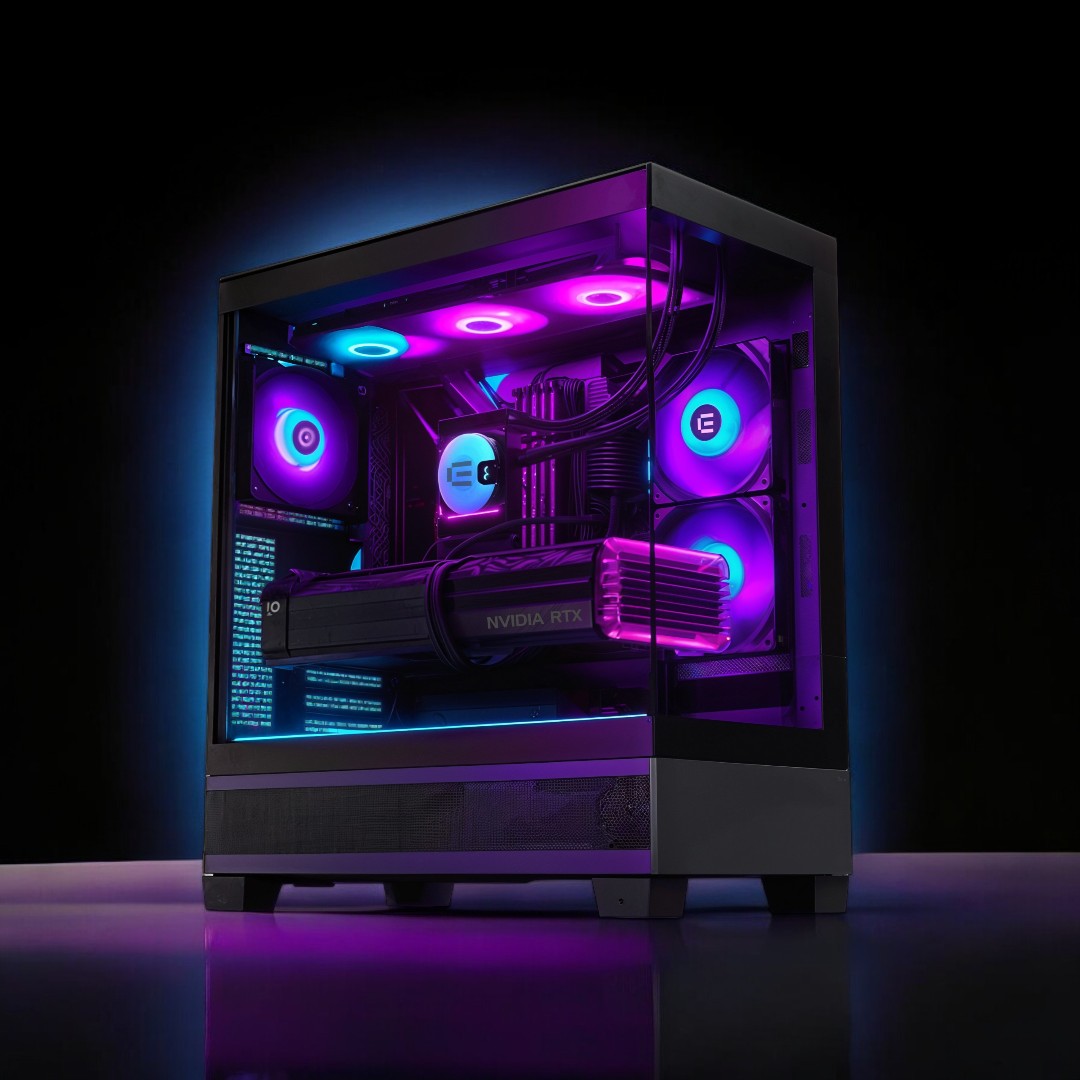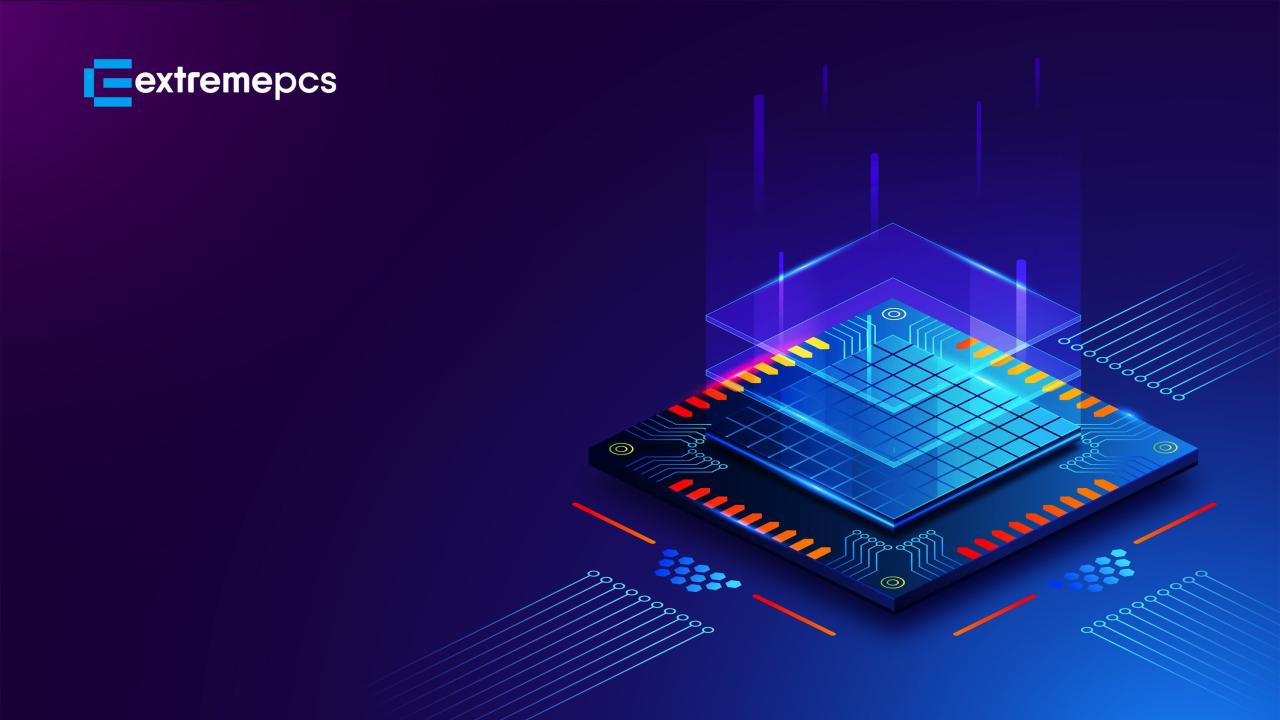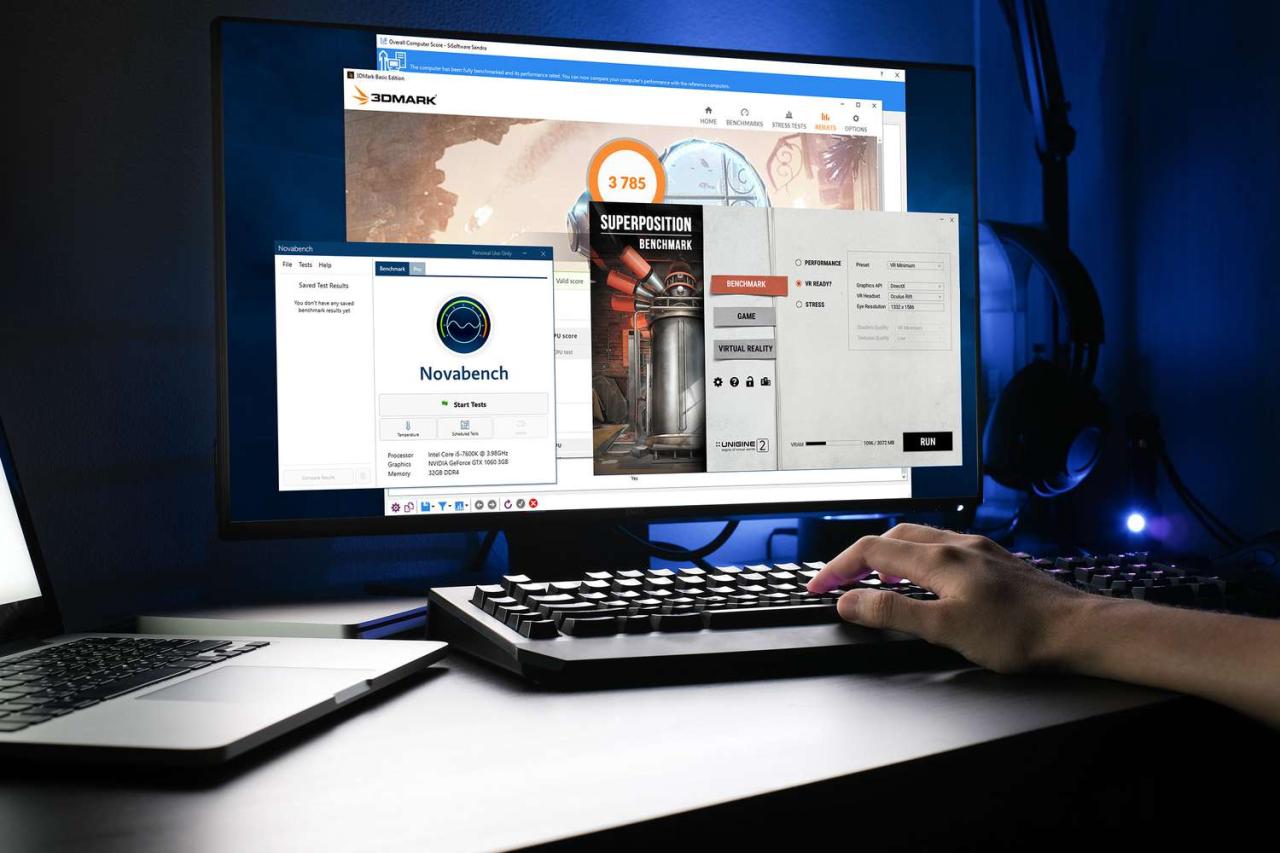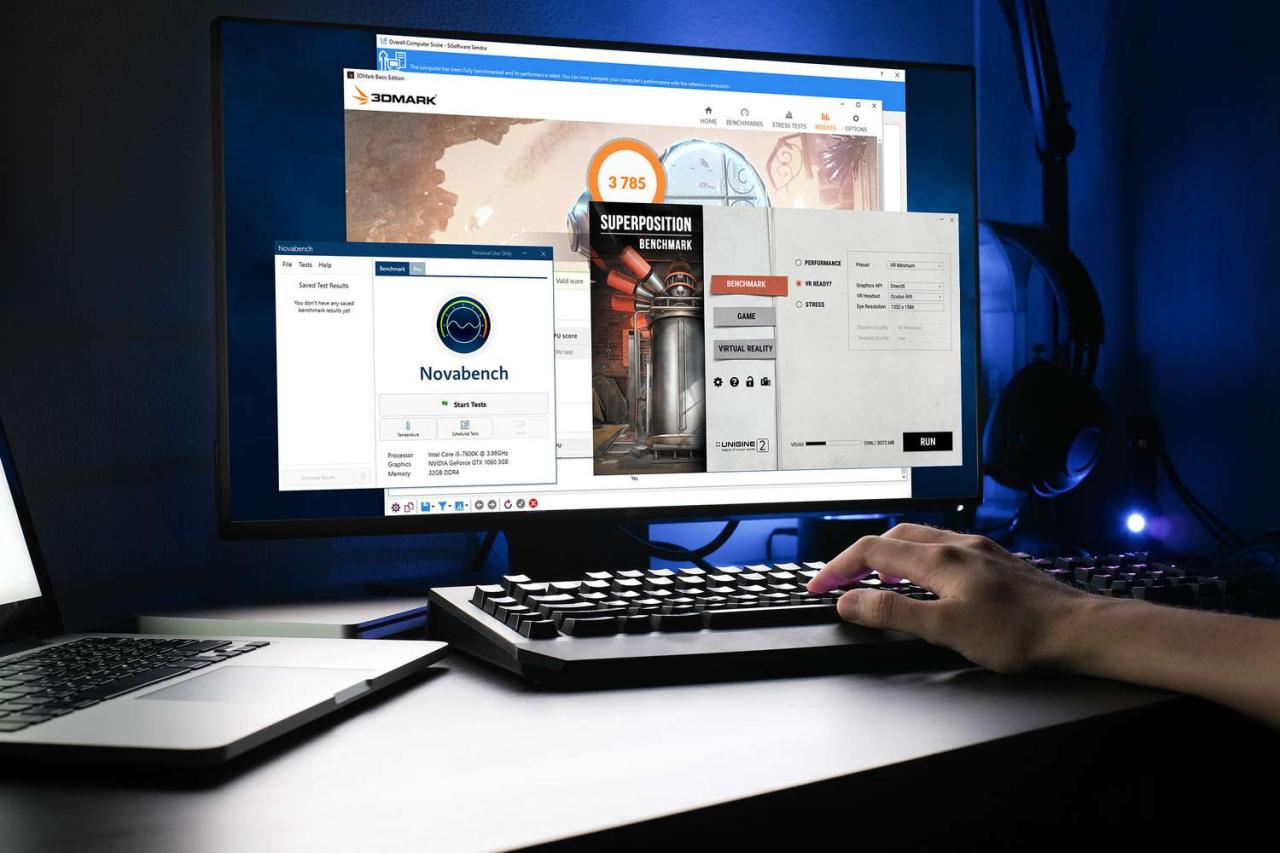Ever dreamed of a PC that pushes the boundaries of performance? This exploration dives deep into the world of extreme PC builds, from defining what makes a system “extreme” to the intricacies of building and maintaining one. We’ll cover everything from the crucial components and their specifications to the software and applications that truly shine on these powerful machines.
Understanding the key differences between extreme and standard PC builds is crucial. Extreme PCs aren’t just faster; they’re optimized for demanding tasks like high-end gaming, professional-grade content creation, and even scientific simulations. This guide will equip you with the knowledge to navigate this fascinating world of cutting-edge technology.
Defining Extreme PC

An extreme PC build transcends the typical home or office computer. It represents a significant investment in high-performance hardware, often pushing the boundaries of what’s practically possible. These systems are meticulously designed for specific, demanding tasks, whether it’s crushing demanding games, rendering intricate 3D models, or tackling complex scientific simulations.Extreme PC builds differ significantly from standard builds in terms of component specifications, cooling solutions, and overall system architecture.
Standard PCs prioritize affordability and general use, whereas extreme PCs prioritize peak performance, reliability, and often, customizability. The crucial difference lies in the raw power and specialized features tailored to meet highly demanding applications.
Key Components of an Extreme PC
The key components that distinguish an extreme PC from a standard one are often upgraded significantly. High-end processors with multiple cores and high clock speeds are fundamental. High-end graphics cards, capable of handling complex visual tasks, are essential for gaming and content creation. Massive amounts of RAM, often exceeding 64GB, are needed for applications demanding large memory footprints.
High-capacity, high-speed storage solutions, such as NVMe SSDs, are crucial for fast data access. High-end power supplies are essential to reliably and efficiently deliver power to all these components. Sophisticated cooling solutions, such as liquid cooling loops, are commonly implemented to manage the heat generated by these powerful components. Extreme PCs also often feature custom-built cases and specialized cabling, designed for optimal airflow and aesthetic appeal.
Types of Extreme PC Builds
Extreme PC builds are tailored to various specific needs. A gaming-focused extreme PC prioritizes high frame rates, low latency, and immersive visuals in games. Content creation extreme PCs emphasize high processing power, large RAM, and fast storage for tasks like video editing, 3D modeling, and rendering. Scientific computing extreme PCs demand powerful processors, massive amounts of RAM, and extremely fast storage for complex calculations and simulations.
Gaming Extreme PC Configurations
Gaming extreme PCs typically feature high-end processors, such as Intel Core i9 series or AMD Ryzen 9 series processors, paired with top-tier graphics cards like NVIDIA RTX 4090 or AMD Radeon RX 7900 XTX. High-end motherboards with excellent connectivity and robust power delivery are crucial. A minimum of 64GB of high-speed RAM is needed to handle demanding game environments and multi-tasking.
High-capacity NVMe SSDs are necessary for fast loading times and smooth gameplay. Extreme gaming PCs also often include custom cooling solutions and robust power supplies, typically exceeding 1000W, to handle the high power demands.
Content Creation Extreme PC Configurations
Content creation extreme PCs are designed for intense workloads like video editing, 3D modeling, and rendering. These builds often feature high-end processors, capable of multi-tasking, along with high-end graphics cards for real-time previews and rendering. Massive amounts of RAM (128GB or more) are vital for large projects. Extremely fast storage, such as multiple NVMe SSDs, is essential for rapid data access and large file handling.
The cooling solution must effectively manage the substantial heat generated during intensive tasks. High-end workstations with professional-grade components are typical.
Scientific Computing Extreme PC Configurations
Scientific computing extreme PCs focus on peak performance for complex calculations and simulations. They typically feature high-core count processors, large amounts of RAM, and extremely fast storage. High-end motherboards are necessary to support these components. The system architecture and cooling solution need to be optimized for prolonged operation under high load. Specific examples include configurations used in climate modeling, protein folding simulations, or large-scale machine learning tasks.
The primary concern is reliable and consistent performance under heavy computational loads.
Components and Specifications

Extreme PCs are distinguished by their meticulously chosen components and optimized configurations. These systems prioritize performance over everything else, often pushing the boundaries of what’s possible with current technology. The focus is not just on raw power but also on stability and sustained performance under demanding workloads.The defining characteristics of an extreme PC extend beyond simple component upgrades.
Sophisticated cooling solutions and meticulously chosen components, each pushing the envelope, are integral to achieving peak performance. Furthermore, the integration of these components into a cohesive and efficient system architecture is critical for achieving optimal results.
CPU Specifications
Extreme PC CPUs are typically characterized by high core counts and elevated clock speeds. These processors are designed to handle multiple tasks concurrently and execute instructions at blazing speeds. The higher core count enables parallel processing, dramatically improving multitasking performance. Higher clock speeds translate to faster instruction execution, enhancing the overall speed and efficiency of the system.
For instance, a 32-core processor running at 5.5 GHz will drastically outperform a 4-core processor operating at 3.5 GHz.
GPU Specifications
High-end GPUs are fundamental to extreme PCs. These components are optimized for graphical processing and are responsible for rendering complex visuals in demanding applications. Crucially, extreme GPUs typically feature substantial amounts of video RAM (VRAM) and a large number of CUDA cores. High VRAM allows for more detailed and intricate graphical representations, while more CUDA cores enhance parallel processing capabilities for graphics, significantly improving rendering speed.
For example, a high-end GPU with 24GB VRAM and 10,000 CUDA cores can handle graphically intensive tasks with remarkable speed and fidelity.
RAM Specifications
Extreme PC systems demand high-capacity RAM to handle demanding tasks. Higher RAM capacity allows the system to store more data in RAM, enabling faster access to this data. This leads to smoother operation and faster response times in demanding applications. Extreme RAM kits often utilize high-speed memory modules, enabling faster data transfer rates. This allows the system to keep pace with the demands of the applications and the high-performance components.
Storage Specifications
High-speed storage is essential for extreme PCs. The rapid access times and high transfer rates offered by high-end storage solutions are critical for applications that demand instantaneous access to large amounts of data. Extreme PCs often utilize NVMe SSDs (Solid State Drives) to maximize data transfer speeds. High-speed storage, in conjunction with high-performance CPUs and GPUs, significantly enhances the overall performance of the system.
Cooling Solutions
Extreme PC components generate substantial heat. Effective cooling solutions are paramount to ensuring the stability and longevity of the system. Overheating can lead to performance degradation and even component failure. Custom liquid cooling systems, with their ability to dissipate substantial amounts of heat, are frequently employed. Furthermore, high-performance fans and advanced thermal paste are crucial for effective cooling of individual components.
For example, custom water-cooling setups can provide superior cooling capabilities compared to stock coolers, preventing the system from throttling under heavy loads.
Component Comparison Table
| Component | Description | Typical Extreme PC Specs | Standard PC Specs |
|---|---|---|---|
| CPU | Central Processing Unit | High core count (e.g., 32 cores), high clock speed (e.g., 5.5 GHz) | Mid-range core count (e.g., 6 cores), standard clock speed (e.g., 3.5 GHz) |
| GPU | Graphics Processing Unit | High VRAM (e.g., 24 GB), high CUDA cores (e.g., 10,000 cores) | Lower VRAM (e.g., 8 GB), fewer CUDA cores |
| RAM | Random Access Memory | High capacity (e.g., 128 GB), high-speed memory modules | Standard capacity (e.g., 16 GB), standard speed memory modules |
| Storage | Data Storage | High-speed NVMe SSDs (e.g., PCIe 4.0) | SATA SSDs or HDDs |
Building and Maintenance
Building an extreme PC involves more than just selecting high-end components; meticulous assembly and ongoing maintenance are crucial for optimal performance and longevity. Proper assembly procedures and advanced cooling solutions are paramount to preventing overheating and ensuring the system’s stability. Understanding potential challenges and implementing best practices are vital to achieving the desired performance and lifespan of this specialized hardware.Careful planning and execution are paramount in the construction of an extreme PC.
This involves more than just assembling parts; it encompasses understanding the intricate interplay between components and ensuring compatibility. The process requires precision and attention to detail, and anticipating potential challenges is essential.
Assembly Process
A systematic approach to assembly is key to avoiding mistakes and ensuring a stable system. The order of installation impacts the overall functionality and prevents damage to delicate components. Starting with the chassis, proceed to installing the motherboard, CPU, RAM, and graphics card. Carefully securing each component is vital. Then install the power supply, storage devices, and any additional hardware.
Lastly, connect the cables and test the system to ensure proper functionality.
Potential Challenges
Several challenges can arise during extreme PC construction. Static electricity is a common concern and can damage sensitive components. Improper component installation can lead to malfunctions or incompatibility issues. Overheating, particularly with high-performance components, is a critical concern that requires robust cooling solutions. Thorough research and careful planning can mitigate these potential difficulties.
Advanced Cooling Techniques
Advanced cooling techniques are essential for managing the heat generated by high-performance components. Liquid cooling systems, such as custom loops, offer superior cooling capabilities compared to air coolers. These systems involve a closed loop of liquid coolant that circulates through the components, dissipating heat more effectively. Properly designed liquid cooling systems can enhance the performance and lifespan of the components.
Specialized fans and optimized airflow within the PC case are other effective cooling strategies.
Maintenance Best Practices
Maintaining an extreme PC involves regular checks and preventative measures. Dust accumulation can significantly impact cooling performance, reducing efficiency and increasing the risk of overheating. Regular cleaning with compressed air and the proper tools is necessary to remove dust and debris from fans and other components. Monitoring component temperatures using specialized software helps detect potential issues early on.
Regularly checking the connections ensures that the system remains stable and avoids any performance degradation.
Step-by-Step Guide for Assembling an Extreme PC
- Prepare the Workspace: Ensure a clean, static-free workspace. Gather all necessary tools and components, including manuals and any additional hardware.
- Install the Motherboard: Carefully place the motherboard into the chassis, ensuring proper alignment and securing it with the provided screws.
- Install the CPU and Cooler: Install the CPU and its corresponding cooler, following the manufacturer’s instructions to avoid damage. Ensure proper thermal paste application for optimal heat dissipation.
- Install RAM: Install the RAM modules into the designated slots on the motherboard, ensuring proper alignment and securing them.
- Install the Graphics Card: Install the graphics card into its designated PCIe slot on the motherboard. Secure the card using the provided screws.
- Install Storage Devices: Install the hard drives and SSDs into the appropriate bays in the chassis.
- Install the Power Supply Unit: Install the power supply unit (PSU) into the chassis and connect the power cables.
- Connect Cables: Carefully connect all the necessary cables to the motherboard, storage devices, and other components. Follow the diagrams provided with the motherboard and components.
- Test the System: Power on the system and check for any errors or malfunctions. Monitor temperatures using specialized software.
Software and Applications
Extreme PCs, with their enhanced processing power and substantial graphical capabilities, unlock a new realm of software and application performance. These systems are not merely upgrades but open doors to specialized software and processes that standard PCs simply cannot handle. Optimizing these applications further enhances their utility and value.Specialized software is often designed to harness the full potential of extreme PC configurations.
This optimization leads to tangible performance improvements, from reduced lag in complex simulations to dramatically enhanced rendering speeds. The resulting improvements can be truly transformative for demanding tasks.
Software Optimized for Extreme PCs
High-performance software, often designed with extreme PC architectures in mind, leverages multiple cores and advanced graphics processing units (GPUs). These applications are specifically tailored to exploit the superior processing capabilities of these machines, delivering significant performance advantages over standard systems.
Examples of Demanding Software
Several software applications require significant processing power. 3D modeling and animation software, for example, demand extensive computational resources to render complex scenes. Similarly, video editing software, particularly when working with high-resolution video or complex editing tasks, benefits from the increased processing power of extreme PCs. Specialized scientific simulations and rendering tasks, often used in fields like engineering or research, also rely on high processing power and specialized software.
Software Benefiting from Extreme PC Configurations
Many software applications benefit from the enhanced capabilities of extreme PCs. For example, complex scientific simulations often benefit from extreme PCs’ processing power. These simulations can be computationally intensive, demanding large amounts of processing power for complex calculations and rendering. Similarly, video game development and high-end gaming benefit greatly from the advanced hardware. The increased processing power allows for more complex game mechanics, higher resolution visuals, and smoother gameplay.
Performance Gains with Optimized Software
The performance gains with optimized software on extreme PCs are often dramatic. For instance, 3D rendering software on an extreme PC can complete a task in a fraction of the time it would take on a standard PC. Similarly, video editing tasks can be completed with higher quality and significantly faster processing times on extreme PCs. In essence, the enhanced performance enables users to accomplish complex tasks much more quickly and efficiently.
Performance Comparison Table
| Software | Description | Performance on Extreme PC | Performance on Standard PC |
|---|---|---|---|
| 3D Rendering Software | Creating 3D models and animations | High speed, low lag, high resolution output | Slow, with significant lag, lower resolution output |
| Video Editing Software | Editing and processing video | High-quality results, fast processing, handling of large video files | Lower quality results, slower processing, struggles with large video files |
| Scientific Simulations | Complex simulations for research and engineering | Faster processing times, ability to handle large datasets | Slower processing times, struggles with large datasets, may crash or not complete tasks |
Cost and Budget Considerations
Building an extreme PC demands a significant financial investment, often exceeding the budget of a standard gaming rig. Understanding the typical costs, influencing factors, and potential savings strategies is crucial for any enthusiast embarking on this endeavor. Factors like component selection, performance goals, and desired features all play a role in shaping the final price tag.
Typical Cost of Building an Extreme PC
The cost of building an extreme PC varies greatly depending on the desired performance level. High-end components, including cutting-edge graphics cards, high-capacity RAM, and top-tier processors, significantly increase the overall price. It’s not uncommon for extreme PCs to cost several thousand dollars, and the cost can easily exceed $5,000 or more depending on the specifics. Budgeting well is essential to ensure you don’t overspend.
Factors Influencing Extreme PC Component Costs
Several factors contribute to the high cost of extreme PC components. Advanced technology, like the latest generation of graphics cards, often utilizes cutting-edge fabrication processes and sophisticated designs, leading to higher production costs. Limited supply and high demand for specific components, particularly during periods of significant technological advancements, can also drive up prices. Furthermore, specialized components, such as high-speed cooling solutions or custom-designed cases, often command a premium due to their unique features and manufacturing complexities.
Budget Levels for Building an Extreme PC
Different budget levels allow for varying degrees of performance and features in an extreme PC. A budget of $3,000 to $5,000 allows for a powerful system with high-end components, including a top-tier graphics card and substantial RAM. A higher budget, potentially exceeding $5,000, opens the door to even more advanced components, such as custom water cooling systems and specialized motherboards with advanced features.
This allows for higher clock speeds, increased bandwidth, and superior cooling. These configurations will often utilize high-end CPU’s, RAM, and SSD storage options.
Savings Strategies for Building an Extreme PC
Several strategies can help reduce the cost of building an extreme PC without compromising performance. Purchasing components from reputable retailers that offer competitive pricing is a key step. Exploring used or refurbished components is another option, which can potentially lower the overall cost. Looking for sales and discounts, comparing prices across different vendors, and choosing components that align with specific performance needs are additional ways to save.
For example, considering a slightly less advanced processor, though still powerful, can reduce costs without sacrificing a significant portion of performance.
Resources for Budget-Friendly Components
Various online retailers and marketplaces offer budget-friendly components for extreme PCs. Websites specializing in PC components provide extensive information about product specifications and reviews, enabling informed decision-making. Online forums and communities dedicated to PC building provide insights into component comparisons, potential deals, and helpful advice from experienced enthusiasts. These resources can greatly help in locating cost-effective alternatives without sacrificing performance.
Future Trends and Advancements

The landscape of extreme PC building is constantly evolving, driven by advancements in semiconductor technology, cooling solutions, and innovative designs. Predicting the future precisely is challenging, but understanding emerging trends provides valuable insight into the potential performance and capabilities of tomorrow’s high-end systems.
Future Architectures
The relentless pursuit of higher clock speeds and core counts in CPUs and GPUs will likely continue. However, the path forward may involve more sophisticated architectural approaches, such as heterogeneous computing. This approach combines specialized processing units for specific tasks, leading to more efficient and powerful systems for particular workloads. For example, AI-specific processors are already showing promise for demanding applications.
Emerging Technologies
Several technologies hold the potential to significantly impact extreme PC building. These technologies include advancements in:
- Quantum Computing: While still in its early stages, quantum computing promises to revolutionize certain computational tasks, potentially impacting fields like cryptography and complex simulations. However, practical implementation within consumer-grade extreme PCs is a distant prospect.
- Advanced Cooling Solutions: The need for efficient heat dissipation will continue to drive innovation. Liquid metal cooling, and more advanced vapor chamber technologies could become mainstream, allowing for denser and more powerful components to be used.
- Customizable and Modular Components: Expect increased modularity in components, enabling greater customization and flexibility in system configurations. This could include more sophisticated and customizable motherboard designs and component mounting systems.
Impact on Performance
The impact of these emerging technologies on extreme PC performance will be profound. Quantum computing, though not immediately practical, has the potential to tackle problems currently intractable for conventional processors. Advanced cooling solutions will allow for more extreme overclocking and thermal limits to be pushed, and modular components will give more freedom in system design and optimization. Increased customization will likely lead to systems perfectly tailored for specific tasks.
For example, high-end workstations could have modular components optimized for rendering or other complex processes.
Potential Future Extreme PC Configuration
A possible future extreme PC configuration could feature:
| Component | Description |
|---|---|
| CPU | A custom-designed CPU with multiple heterogeneous cores, including AI acceleration cores and conventional cores. |
| GPU | A high-end GPU with advanced ray tracing capabilities, integrated quantum computing co-processors (for limited tasks), and high-bandwidth memory. |
| Memory | High-bandwidth, low-latency memory with potentially new architectures designed to maximize data transfer speeds and reduce latency. |
| Cooling | A custom liquid metal cooling system with advanced thermal management software to maintain stable temperatures during extreme loads. |
| Power Supply | A modular, high-efficiency power supply with multiple outputs, capable of handling the high power demands of the components. |
Conclusion
In conclusion, building an extreme PC is a journey into high-performance computing. From meticulous component selection to advanced cooling techniques, the process demands careful consideration. While the cost can be substantial, the rewards—unrivaled performance and the ability to tackle complex tasks—can be significant. This guide has provided a comprehensive overview, empowering you to understand the intricacies of extreme PC builds and their potential.
FAQ Resource
What are the most common cooling solutions for extreme PC components?
Extreme PC builds often require custom water cooling loops, liquid nitrogen cooling, or high-performance air coolers. These solutions address the heat generated by powerful components like CPUs and GPUs.
What software benefits significantly from extreme PC configurations?
Software demanding heavy processing, such as 3D rendering, video editing, and scientific simulations, will experience substantial performance gains on extreme PCs. These applications utilize the high processing power and memory capacity of extreme components.
How can I find budget-friendly components for an extreme PC build?
While high-end components are often expensive, you can find budget-friendly options by researching and comparing different brands and models. Websites specializing in PC parts and forums dedicated to extreme PC builds often have valuable information on affordable alternatives.
What are some potential challenges in building an extreme PC?
Building an extreme PC can present challenges related to component compatibility, cooling requirements, and the complexity of the assembly process. Careful planning and research are essential to mitigate these potential issues.






